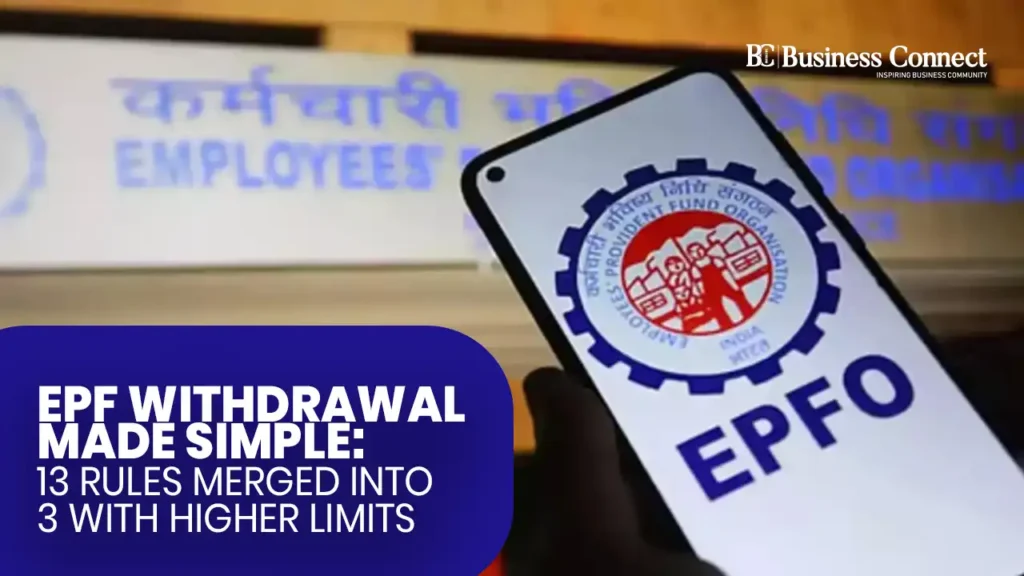By combining 13 regulations into three categories, increasing restrictions, cutting service to 12 months, and other changes, EPFO’s Central Board of Trustees simplifies EPF withdrawals.The Central Board of Trustees (CBT) of the Employees’ Provident Fund Organization (EPFO) has approved significant modifications to liberalize and simplify partial withdrawal procedures under the EPF Scheme in an effort to improve the Ease of Living for employees. Thirteen intricate laws are combined into a single, simplified framework.
EPF Withdrawal Simplified: Key Changes in EPFO Reforms You Must Know
The Employees’ Provident Fund Organisation (EPFO) has recently announced major reforms aimed at simplifying the EPF withdrawal process for subscribers. With the new changes, the previously complex system of 13 separate withdrawal rules has now been streamlined into just 3 key rules, making it easier and faster for employees to access their funds.
Key Highlights of the EPF Reforms
Simplified Withdrawal Process
The 13 existing withdrawal rules have been consolidated into three main categories, reducing paperwork and processing time.
Subscribers can now withdraw their EPF savings with minimal documentation and fewer bureaucratic steps.
Higher Withdrawal Limits
The new rules allow higher withdrawal limits for specific needs such as medical emergencies, housing, and education.
This provides greater financial flexibility for EPF members, particularly during urgent situations.
12-Month Service Requirement
To be eligible for certain EPF withdrawals, subscribers need to have completed at least 12 months of continuous service.
This change ensures that long-term contributors can benefit from their accumulated funds more efficiently.
What This Means for EPF Subscribers
Faster Access to Funds: The streamlined rules will significantly reduce the time it takes for employees to receive their EPF withdrawal amounts.
Clearer Guidelines: Fewer rules mean less confusion for subscribers trying to understand their eligibility and withdrawal limits.
Enhanced Flexibility: With higher withdrawal limits, employees can now cover bigger expenses like medical bills or home construction costs without financial strain.
How to Withdraw EPF Under the New Rules
Visit the EPFO official portal: https://www.epfindia.gov.in.
Log in using your Universal Account Number (UAN) and password.
Navigate to “Online Services” → “Claim (Form-31, 19, 10C & 10D)”.
Choose the type of withdrawal based on the updated rules.
Submit the request and track the status online.
A Complete Guide to EPFO Forms: How to Manage Your Provident Fund Efficiently
Managing your Employees’ Provident Fund (EPF) account involves more than just tracking your balance. The Employees’ Provident Fund Organisation (EPFO) requires specific forms for various purposes—whether it’s withdrawing funds, transferring your account, applying for a pension, or financing an LIC policy. Submitting the correct form ensures your request is processed quickly and without unnecessary delays. Here’s a detailed guide to help you navigate the different EPFO forms and when to use them.
If You Are Currently Working
For Advance Withdrawal:
Use the Composite Claim Form (Aadhaar) or Composite Claim Form (Non-Aadhaar).
The Aadhaar-based form can be used if your Aadhaar, bank account, and Form 11 (New) details are updated on the UAN portal.
You can submit this form directly to the EPFO office without employer attestation.
For Financing Your LIC Policy:
Submit Form 14 to utilize your EPF balance for LIC premiums.
For Monthly Pension (After 10 Years of Service):
Apply using Form 10D to start receiving your pension benefits.
For Withdrawal Benefits (Under 10 Years of Service and Age 58):
Use the Composite Claim Form (Aadhaar or Non-Aadhaar) for settlement of your EPF account.
If You Have Left Your Organisation
For PF Transfer to a New Employer:
Submit Form 13 to transfer your account seamlessly.
For Final PF Settlement (After Leaving and Not Joining Another Organisation):
Wait for a period of two months before applying.
Use the Composite Claim Form (Aadhaar or Non-Aadhaar) for withdrawal.
If you have completed 10 years of service, you are also eligible to apply for a Scheme Certificate from the pension fund.
If a Member Passes Away Before 58 Years of Age
For Final PF Settlement:
Submit Form 20 for the deceased member’s PF.
For Monthly Pension Benefits to Family:
Apply using Form 10D.
For Insurance Claims under EDLI Scheme:
Use Form 5IF to claim insurance benefits.
EPFO subscribers must select the correct form based on their purpose, whether it’s for withdrawal, transfer, pension claim, or insurance benefits. Using the right form ensures faster processing and avoids unnecessary delays. Additionally, keeping your UAN details updated on the EPFO portal is crucial for a smooth experience.
Final Thoughts
The EPFO reforms are a welcome change for employees across India, offering a simpler, faster, and more flexible way to access their hard-earned savings. By consolidating rules and increasing limits, EPF withdrawals have become more transparent and user-friendly, benefiting millions of subscribers nationwide.



